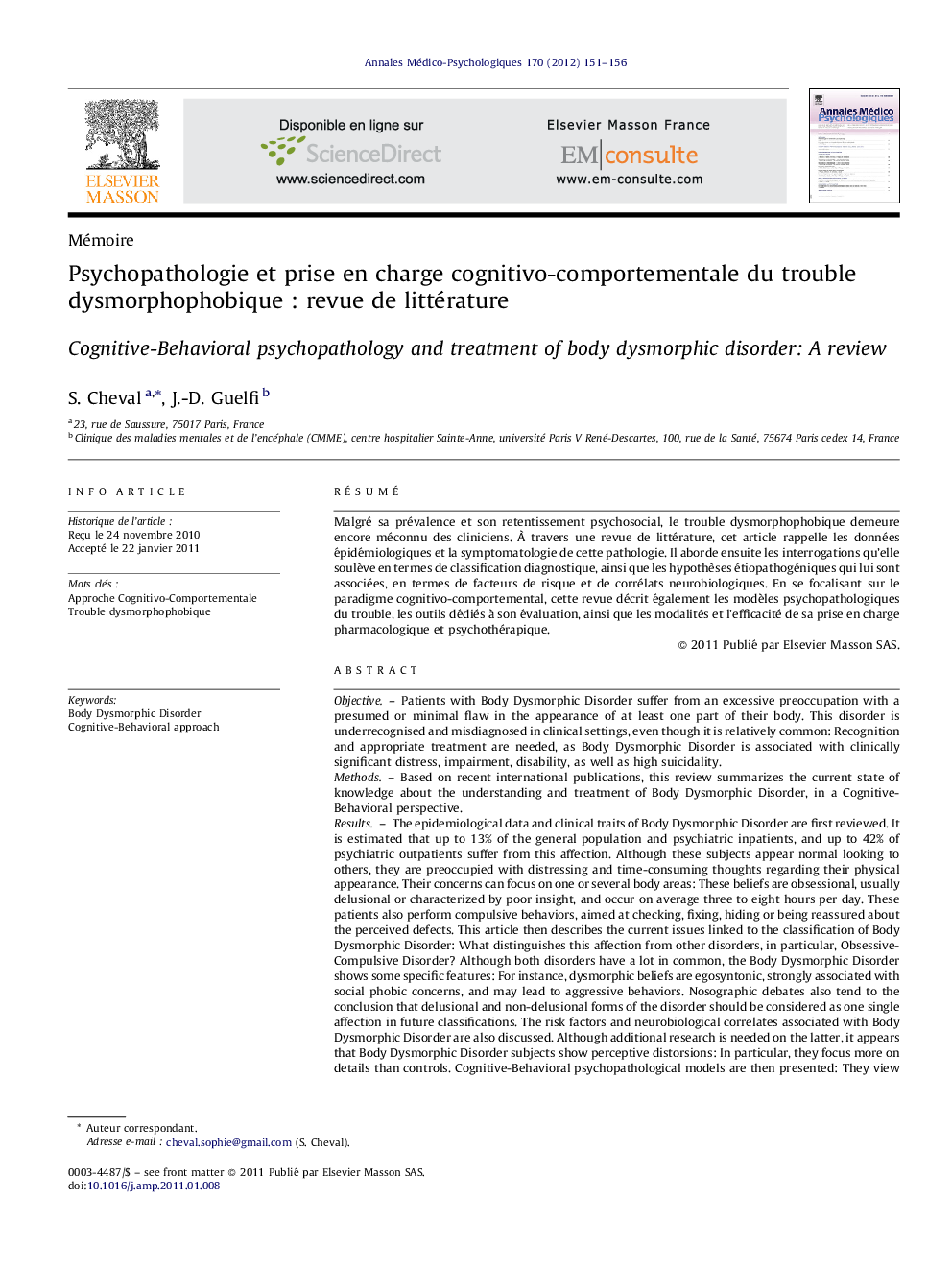| Article ID | Journal | Published Year | Pages | File Type |
|---|---|---|---|---|
| 313505 | Annales Mdico-psychologiques, revue psychiatrique | 2012 | 6 Pages |
RésuméMalgré sa prévalence et son retentissement psychosocial, le trouble dysmorphophobique demeure encore méconnu des cliniciens. À travers une revue de littérature, cet article rappelle les données épidémiologiques et la symptomatologie de cette pathologie. Il aborde ensuite les interrogations qu’elle soulève en termes de classification diagnostique, ainsi que les hypothèses étiopathogéniques qui lui sont associées, en termes de facteurs de risque et de corrélats neurobiologiques. En se focalisant sur le paradigme cognitivo-comportemental, cette revue décrit également les modèles psychopathologiques du trouble, les outils dédiés à son évaluation, ainsi que les modalités et l’efficacité de sa prise en charge pharmacologique et psychothérapique.
ObjectivePatients with Body Dysmorphic Disorder suffer from an excessive preoccupation with a presumed or minimal flaw in the appearance of at least one part of their body. This disorder is underrecognised and misdiagnosed in clinical settings, even though it is relatively common: Recognition and appropriate treatment are needed, as Body Dysmorphic Disorder is associated with clinically significant distress, impairment, disability, as well as high suicidality.MethodsBased on recent international publications, this review summarizes the current state of knowledge about the understanding and treatment of Body Dysmorphic Disorder, in a Cognitive-Behavioral perspective.ResultsThe epidemiological data and clinical traits of Body Dysmorphic Disorder are first reviewed. It is estimated that up to 13% of the general population and psychiatric inpatients, and up to 42% of psychiatric outpatients suffer from this affection. Although these subjects appear normal looking to others, they are preoccupied with distressing and time-consuming thoughts regarding their physical appearance. Their concerns can focus on one or several body areas: These beliefs are obsessional, usually delusional or characterized by poor insight, and occur on average three to eight hours per day. These patients also perform compulsive behaviors, aimed at checking, fixing, hiding or being reassured about the perceived defects. This article then describes the current issues linked to the classification of Body Dysmorphic Disorder: What distinguishes this affection from other disorders, in particular, Obsessive-Compulsive Disorder? Although both disorders have a lot in common, the Body Dysmorphic Disorder shows some specific features: For instance, dysmorphic beliefs are egosyntonic, strongly associated with social phobic concerns, and may lead to aggressive behaviors. Nosographic debates also tend to the conclusion that delusional and non-delusional forms of the disorder should be considered as one single affection in future classifications. The risk factors and neurobiological correlates associated with Body Dysmorphic Disorder are also discussed. Although additional research is needed on the latter, it appears that Body Dysmorphic Disorder subjects show perceptive distorsions: In particular, they focus more on details than controls. Cognitive-Behavioral psychopathological models are then presented: They view the Body Dysmorphic Disorder as a bio-psycho-social disorder, and describe the factors possibly involved in its pathogenesis and development. This article also reviews the main psychometric scales used to detect and assess this disorder, as well as the specificities of Cognitive-Behavioral Therapy applied to Body Dysmorphic Disorder. Finally, the findings to date regarding the effectiveness of pharmacotherapy and Cognitive-Behavioral psychotherapy of Body Dysmorphic Disorder are considered. The prescription of serotonine reuptake inhibitors antidepressants seems effective in the treatment of this affection, but further investigation is needed and currently under development. Cognitive-Behavioral psychotherapy also shows positive results, although the respective impact of cognitive and behavioral factors is warranted. Beside from the replication of current results on larger samples, additional research is also required regarding the efficacy of combining pharmacotherapy and psychotherapy: Future research should assess the value of third generation therapy (such as mindfulness, for example) as well.
